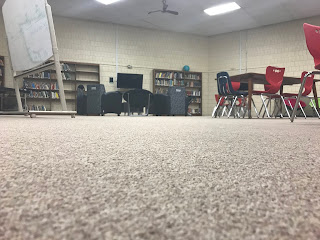When I was in school, I was never a “math guy.” However, I know that if I would have had the two math teachers that are at UJHS they may have persuaded me to think otherwise. I am continually impressed when I walk into a math lesson at the way that our teachers make the skills seem so simplistic while challenging them to meet rigorous standards.
Last month, Ms. Todd invited me down to do some observation for an impact cycle. In our initial meeting, I asked her the question that I ask every teacher when we begin an impact cycle, “what don’t you like about how your courses are going right now. What is really hitting you in the gut that you would like to change.”
I have found that when I phrase this question this way, I get more authentic feedback than what I used to get when I asked teachers the question, “so how are things going.” The typical red-blooded American teacher answer is the response, “fine!” At times it seems like this has become just an automatic response, just as one might use “hello,” “goodbye,” or “have a good weekend.” I struggled for some time in the past starting good conversations because I wasn’t asking the right questions. When I asked Ms. Todd this, she thought for a moment and said, “actually would you mind coming into my eighth-hour class. I’m just not sure they are as engaged as I would like them to be.”
In an observation, I found the opposite. It seems that almost all of her students were engaged, but a select few seemed to dominate a lot of the question and answering during whole class problem solving and discussion. After analyzing the data, we also found that there was a small pocket of students in the back that easily became off task because of the learning environment at that table. One student towards the front of the room was on task and thoroughly engaged, but as a teacher, it would be difficult to tell because of her seat. With the setup of the room, she was the only student who had her back to the teacher nearly all the time. A few simple changes to the learning environment went a long way.
We then discussed what other goals she had. She was looking for different ways to engage her students in real-world introductory lessons that exposed students to the last several chapters, a precursor to what they would be exploring in 7th-grade math. Thank you @GHSnmath for your help with a few of these!
Here is what she would like to explore as possible options:
Generating Equivalent Algebraic Expressions:
Focus: Student Agency
- Have students choose a demonstration on how Algebraic Expressions can be used to explain activities in their day-to-day lives.
- Examples
- Create a Game
- Like the game headbands. Each student has an expression on their head.
- 3x - y - y; 4x + 12; 2x -2y + x; 4(x+3), etc.
- The teacher calls out “let x = 3 and y = 2.” Evaluate the partners expression and record results. Do this x number of times. At the end, based on your results, find another expression that matches yours.
Collecting data
Students develop a two variable, single day experiment, or find something experimental to collect data on. Perhaps rolling dice?
- Collect data results in a table
- Representing relationships in the table
- Create graphical representations of data using Google sheets
- Highlight Relationships
- Could this be taught in parallel with Unit 16?
Area & Polygons
- Discover total area needed for replacing the carpet in the newly redesigned media center for hardwood floor or newer carpet and what the total cost would be.
- Redesign the media center using 3D modeling
- Identify the appropriate size are conditioning unit for each part of the school (BTU’s and Square Footage) using blueprints provided by Mr. Whitsitt.
Distance and Area in the Coordinate Plane
- Arrange Desks within the class using a coordinate plane. Measure area between desks or the whole room as well as the distance between desks.
- Treasure Hunt
- Modify checkers using the Coordinate Plane
- Modify a game of battleship
- Minecraft, Minecraft Treasure Hunt
- Overlay with an aerial map to locate places within the grid and distance apart--City Map of Monmouth Wards
- Virtual Archeological digs
- Crime Scene Investigation
Surface Area and Volume of Solids
- amount of paint to paint the Media Center
- amount of paint to repaint the entire school.
- amount of water that could fill the school
- Surface area required to create lift on a plane
- The volume of an instrument: Guitar … how does volume affect the sound
Displaying Analyzing and Summarizing Data
- Could this be taught parallel to the 2 variable lessons? In which they design an experiment, collect the data, then display analyze and summarize the data?
- Analyze student selection for school lunches
- Real world examples
- Integration of Technology: PSPP?

It's easy and rewarding to connect to the real world in math class. On the Information Highway," we can find online collections of real-world math activities, math activities with a specific real-life focus, online data sources, portals for joining or launching collaborative math and science projects, and more. Real world math projects help us to learn math easily. Maths is the only subject which you can learn after a lot of practice and hard work. I completed my education from Singapore. I want to share with students Why is Singapore Math so Popular Overseas?. Thanks for this beneficial article.
ReplyDelete